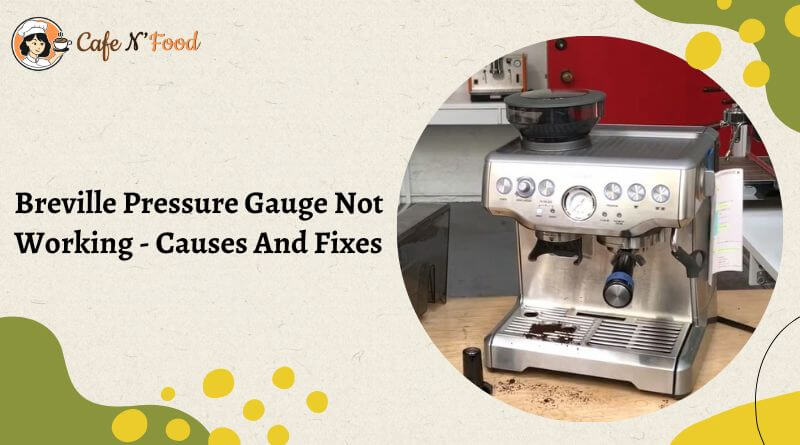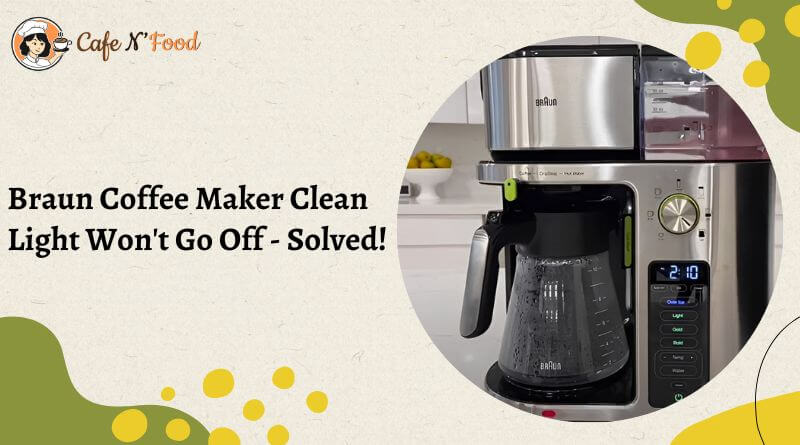Hey there! This post contains affiliate links to products. We may receive a commission for purchases made through these links. But it never influences our product selection process.
Do you need help making coffee with your Cuisinart Coffee Center? There is no need to worry if you’ve faced Cuisinart coffee center k cup problems. K-Cup users may encounter common Cuisinart Coffee Center problems in this guide.
Problems include Inadequate water supply, lid leaks, clogged filters, power issues, etc. For optimal Cuisinart Coffee Center K-Cup performance, first use compatible K-Cups. Then clean puncture needles regularly and descale them periodically. Also, ensure proper K-Cup insertion. Finally, contact support for persistent issues.
Here’s how to ensure your Cuisinart Coffee Center consistently produces perfect coffee. Maintaining your coffee machine and addressing brewing inconsistencies ensures a delightful, satisfying experience.
Cuisinart Coffee Center K Cup Problems – 5 Common Issues And Solutions

Several factors can cause the Cuisinart coffee maker K cup not working in Cuisinart Coffee Center machines, but Cuisinart coffee maker with K Cup troubleshooting can greatly improve your experience. Come on, let’s talk in detail.
Issue 1: Inadequate Water Supply in Cuisinart Coffee Center with K-Cups
If the water reservoir is not filled to the appropriate level, the coffee maker might need more water to complete the brewing process. There may be a problem with the water pump that moves water through the coffee maker. Water lines or tube clogs can restrict the water flow from the reservoir to the brewing mechanism.
Solution:
To address inadequate water supply issues in your Cuisinart Coffee Center when using K-Cups, follow these steps:
- Ensure the reservoir is adequately filled for your desired cup size.
- Regularly descale and clean water reservoirs, lines, and tubes to prevent clogs.
- Contact customer support or a technician to check the water pump functionality.
- Run a water-only cycle to flush out debris or buildup.
- Prevent mineral deposits by using filtered or distilled water.
- Follow the manufacturer’s cleaning and descaling recommendations.
Following these steps, you can address and prevent inadequate water supply issues using K-Cups with your Cuisinart Coffee Center.
Issue 2: Coffee Maker Lid Leaking
The lid might need to be properly aligned or closed, causing gaps where liquid can escape during brewing. The rubber gasket or seal on the lid could be worn out, cracked, or damaged, allowing liquid to leak.
Also, Pressure buildup during brewing can cause leaks if the lid cannot withstand it or if the seal is compromised. Coffee grounds, oils, or debris on the sealing surface can prevent a proper seal, leading to Cuisinart coffee maker K cup leaking.
Solution:
Here’s how you can solve this issue:
- Ensure the lid is properly aligned and securely closed before starting the brewing process.
- Inspect the rubber gasket or seal on the lid for any signs of wear or damage. If needed, replace the gasket with a new one from the manufacturer.
- If your coffee maker has a pressure release valve or button, release excess pressure before opening the lid after brewing.
- Regularly clean the sealing surface of the coffee maker
- Do not overfill the water reservoir, as excessive liquid could lead to pressure-related leaks.
- Follow the manufacturer’s instructions for lid maintenance and care
- If the issue persists, contact the coffee maker’s customer support for further assistance.
Issue 3: Power Issues
When your Cuisinart coffee maker k cup lights flashing or you experience power-related problems, several factors can play a role. The coffee maker may only receive power if properly connected to a power outlet.
Verify that the power switch is in the “On” position, as an overlooked or mispositioned switch can lead to apparent power failures. Power cord damage or fraying can disrupt power to the coffee maker.
External factors, including tripped circuit breakers and blown fuses, can affect the coffee maker’s ability to start. Furthermore, internal wiring faults or malfunctioning components within the coffee maker might be causing the power problem.
Solution:
You can follow these tips to fix the problem:
- Make sure the coffee maker is securely plugged into a functioning power outlet. Try plugging in another device to verify that the outlet is working.
- Double-check that the power switch is in the “On” position. Sometimes it might be easy to overlook.
- Examine the power cord for visible damage or fraying. If damaged, replace the cord with a new one from the manufacturer.
- Check your home’s circuit breaker panel or fuse box to see if a circuit breaker has tripped or a fuse has blown. Reset the breaker or replace the fuse if necessary.
- Some coffee makers have a reset button. Refer to the user manual for instructions on how to perform a reset.
- Try plugging the coffee maker into a different power outlet to rule out any issues with the original outlet.
- Sometimes, the coffee maker’s safety features might prevent it from turning on immediately after a power interruption. Please wait a few minutes, and then try turning it on again.
Note: Always follow safety guidelines when dealing with electrical appliances and power-related issues. If you’re uncertain about performing any troubleshooting steps, it’s best to seek professional help to avoid any risks or hazards.
Issue 3: Clogged Filters in K-Cup Coffee Maker
Most of the time, minerals from hard water gradually obstruct the filter’s pores, affecting water flow and the brewing process. A blockage in the water pathways can also occur when fine coffee grounds bypass the filter.
Coffee oils and residue can clog filters, impacting water filtration efficiency. Neglecting regular maintenance and cleaning routines can further contribute to filter clogs.
Note: If your Cuisinart coffee maker clogged valve, click this link, offers step-by-step instructions on how to solve, clean, and maintain your machine for optimal brewing performance.
Solution:
You must try these to resolve the issue:
- Clean the filters after each use by removing and rinsing them with warm water. Allow them to dry before reinserting.
- Perform regular descaling using equal parts water and white vinegar to remove mineral deposits from filters and other parts of the coffee maker.
- Opt for coarser coffee grounds to prevent fine particles from passing through the filter and causing clogs.
- If filters are damaged or heavily clogged, consider replacing them with new ones.
- Develop a regular cleaning routine for your coffee maker, including filters, to prevent buildup.
- Some coffee makers have a backflushing function to clear clogs. Consult the user manual for instructions.
- If clogs persist or are severe, seek professional maintenance or contact customer support for assistance.
Issue 5: Faulty Heating Element

A faulty heating element in a coffee maker can arise due to several potential factors. As the heating element is continuously exposed to high temperatures, it becomes worn and deteriorates, eventually malfunctioning.
Voltage fluctuations or electrical issues can also contribute to the element’s failure. When the coffee maker is not descaled regularly, mineral deposits can accumulate on the heating element, impairing its ability to heat water effectively.
Manufacturing defects or poor quality control during production can also lead to premature heating element failure.
Solution:
You can solve the issue this way:
- If you suspect a faulty heating element, you should seek assistance from a professional technician or the manufacturer’s customer support.
- Ensure the coffee maker is properly connected to a stable power source because voltage irregularities can impact the heating element’s performance.
- Regularly descale the coffee maker using manufacturer-recommended descaling solutions to prevent mineral buildup on the heating element.
- If the heating element is confirmed to be faulty, consider replacing it with a genuine replacement part from the manufacturer.
- Check if your coffee maker is still under warranty, as a faulty heating element might be covered for repair or replacement.
How To Clean Cuisinart Coffee Maker K-cup Side?
Cleaning your Cuisinart coffee maker’s K-Cup side is essential for maintaining optimal performance and ensuring the quality of your brewed coffee. Follow these eight detailed steps to clean the K-Cup side of your Cuisinart coffee maker effectively:
Step 1: Collect the necessary cleaning supplies: white vinegar, water, a soft brush or toothbrush, a microfiber cloth, and a sink or basin.
Step 2: Ensure the coffee maker is turned off and unplugged to prevent electrical accidents while cleaning.
Step 3: Please remove the water reservoir and drip tray from the coffee maker and set them aside.
Step 4: If there’s a used K-Cup in the holder, carefully remove it and dispose of it appropriately.
Step 5: Dampen a soft cloth or sponge with a mixture of equal parts white vinegar and water. Gently wipe down the K-Cup holder’s interior, paying attention to the punctured needle. Use a soft brush or toothbrush to scrub gently if there’s any stubborn residue.
Step 6: Wash the drip tray and water reservoir with warm, soapy water. Rinse thoroughly and dry them before reinserting.
Step 7: If you notice mineral deposits or scaling on the K-Cup side, perform a descaling process by mixing equal parts white vinegar and water.
Step 8: Fill the water reservoir halfway, place an empty cup on the drip tray, and initiate a brew cycle. Repeat this process once more, using water to rinse out any vinegar residue.
Step 9: Once all components are clean and dry, reassemble the coffee maker. Insert an empty cup and run a water-only brewing cycle to flush out any remaining cleaning solution or residue.
Your Cuisinart coffee maker’s K-Cup side is now clean and ready for brewing delicious coffee!
Warning Tips for Cleaning Your Cuisinart Coffee Maker:
Before cleaning, disconnect the coffee maker from the power source to avoid electrical hazards.
- Let the coffee maker cool after use to prevent burns while cleaning.
- Only immerse part of the unit in water; focus on removable parts.
- Use soft cloths and gentle brushes to prevent damaging sensitive parts.
- Use vinegar in a well-ventilated area and rinse thoroughly to avoid affecting taste.
- Ensure components are correctly assembled to prevent leaks or malfunctions.
- Keep water away from electrical components to prevent damage.
- Check cords and parts for wear; discontinue use if damaged.
- Follow instructions for descaling solutions and ensure proper rinsing.
- To prevent mold or hazards, let components dry fully before reassembly.
Frequently Asked Questions (FAQs):
Why do coffee pods explode in my Cuisinart coffee maker?
Incorrectly sealed K-Cups can lead to messy explosions during brewing. Inspect the seal before use. If not properly sealed, contact the manufacturer for a refund.
Can you use K cups with Cuisinart Coffee Center?
Cuisinart Coffee Centers are compatible with K-Cups, offering convenience and variety in brewing options.
What is the problem with coffee pods?
Certain plastic pods contain endocrine-disrupting chemicals (BPF and BPS) linked to hormone imbalances, weight gain, and fertility issues, prompting health concerns.
Why is my coffee machine bubbling?
Bubbles in your coffee machine could indicate trapped air or pressure buildup during brewing. It is possibly due to a clog or malfunction.
How long should a coffee pod machine last?
The typical lifespan of a coffee pod machine can vary but generally ranges from 3 to 5 years, depending on usage and maintenance.
Final Thoughts
You can address and resolve Cuisinart Coffee Center K-Cup problems to ensure a pleasant coffee experience. Making every cup a satisfying experience begins with proper use, regular maintenance, and seeking assistance when necessary.
However, the issues may differ from machine to machine and are not universal. Research customer reviews and consider personal preferences before making a purchase. Finding the right coffee machine for your needs is crucial in ensuring a satisfying cup of joe each morning.





